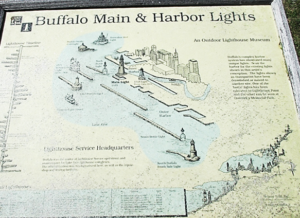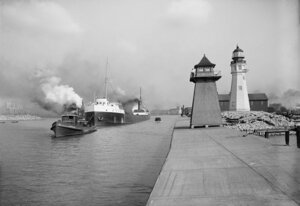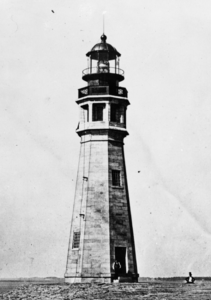Lighting the Way:
The Buffalo Lighthouse and its Lasting Legacy
Danielle Cairns
Buffalo - 2025
The Buffalo Lighthouse stands as a historic beacon of resilience strategically positioned at the confluence of the Buffalo River and Lake Erie. Serving as a vital navigational aid, it played a crucial role in safeguarding maritime trade, fostering Buffalo's emergence as a key Great Lakes port and supporting the city's industrial growth. Beyond its practical function, the lighthouse embodies cultural significance, reflecting Buffalo's evolving relationship with waterways- from Indigenous trade networks to the bustline industrial economy of the 19th and early 20th centuries. Technological advancements, such as the introduction of Fresnel lenses and structural reinforcement, transformed the lighthouse into a model of maritime ingenuity, ensuring the safe passage of goods and people. This is highlighted through the historical context of the lighthouse and its architectural and technological advancements, the challenges faced in its maintenance, and its lasting impact on Buffalo's economic and cultural development.
Historical Context
Before European settlement, the region around Buffalo was a crucial crossroad for Indigenous trade and communication. The Haudenosaunee and other Native groups utilized the extensive networks of waterways, including the Buffalo River and Lake Erie, to exchange goods, ideas and cultural practices. These Indigenous trade routes linked the Great Lakes with the Ohio Valley and beyond, facilitating commerce long before the lighthouse construction. 1 The waterways were economic conduits and held deep cultural and spiritual significance for Indigenous Peoples. 2

Figure 1: Buffalo Main and Harbor Lights, 1833.
With the completion of the Erie Canal in 1825, Buffalo underwent a rapid transformation, emerging as a central transportation hub. The canal, often referred to as the "Gateway to the West," connected the Great Lakes to the Atlantic Ocean, accelerating trade and attracting waves of immigrants, primarily Germans and Irish.3 These labourers played a pivotal role in constructing not only the canal but also the Buffalo Lighthouse, which was completed in 1833.4 Positioned at the mouth of the Buffalo River, the lighthouse ensured safe navigation for the increasing number of vessels entering the harbour, solidifying Buffalo's roles as a key gateway for commerce. 5 Figure 1 illustrates the complex network of lighthouses that guide the ship through Buffalo harbour, highlighting the city's development as a significant trade hub. 6 The map showcases multiple lights, including the Buffalo Main Light, which played a crucial role in ensuring safe passage for vessels navigating Lake Erie and the Buffalo River.7
Throughout the 19th century, Buffalo grew into a major shipping center, handling commodities such as grain, coal, and steel. 8 The lighthouse played a crucial role in maintaining the steady flow of these goods, which fueled the city's economic expansion. As Buffalo waterfront developed, the lighthouse became an essential component of maritime infrastructure, facilitating not only trade but also cultural exchange as immigrant communities established themselves and shaped the city's identity.9
Architectural and Technological Advancements
Constructed in 1833, the Buffalo Lighthouse was a testament to early 19th-century architectural ingenuity. Constructed from local limestone, it featured a hexagonal design that enhanced resistance to wind and water erosion.10 This structural choice ensured durability against the harsh weather conditions of Lake Erie, making it a reliable beacon for decades. Additionally, the lighthouse's foundation was reinforced with oak piling to prevent shifting due to the unstable shoreline, a common issue with early lighthouses along the Great Lakes.

Figure 2: Harbour Entrance and Lighthouse, 1915.
Technological advancements further improved the lighthouse's effectiveness. In the late 19th century, rapid-flashing lights were installed, significantly increasing visibility and reliability at the Buffalo port.11 Figure 2 illustrates how this advancement was critical for ensuring the safe passage of ships navigating the port and surrounding waters.12 Buffalo's bustling harbour saw a variety of vessels carrying grain, coal and manufactured goods.13
The introduction of the Fresnel lens revolutionized lighthouse operation, as its prismatic glass rings concentrated light into a powerful beam visible over greater distances, reducing maritime accidents.14 These lenses were not only more effective in terms of energy consumption, but also extended the lighthouse service life by requiring less fuel.15 The Fresnel lens, developed by French physicist Augustin-Jean Fresnel, revolutionized lighthouse operations by utilizing concentric prismatic glass rings to focus and amplify light into a concentrated beam.16 This innovation significantly extended the lighthouse visibility, reducing maritime accidents and improving navigation for the increasing number of vessels utilizing Buffalo's Port.17 Additionally, the Fresnel lens was far more efficient, requiring less fuel than traditional oil lamps, which would lower operational costs. In 1902, fol9lowing the Pan-American Exposition, a world fair showcasing the latest cultural and technological advancements, the Lighthouse board revised the light's characteristic from a fixed white flow to a flashing pattern every six seconds, making it more distinguishable against the backdrop of the burgeoning city lights.18
Additional modifications in the late 19th and early 20th centuries included the installation of an incandescent oil vapour lamp in 1885, and a steam fog whistle in 1890 to aid navigation in adverse weather. 19 These enhancements reflect Buffalo's dedication to maintaining maritime infrastructure. However, as the harbour grew, the lighthouse function evolved from a primary navigational aid to a pierhead light. In 1912, the federal government allocated $60,000 for the construction of a new breakwater lighthouse, completed in 1914, which further modernized Buffalo port operations.20
Challenges and Maintenance
Despite its technological advancement, the Buffalo Lighthouse faced numerous challenges, particularly due to the harsh environmental conditions of Lake Erie. Ice floes in winter exerted immense pressure on its foundation, necessitating regular maintenance to prevent structural damage. Crews often had to chip away accumulated ice to ensure the beacon remained operating.21 Additionally, the constant battering of waves eroded the lighthouse, leading to frequent repairs and reinforcement efforts.
Historical records, such as the 1912 estimate of repair costs, illustrate the significant resources required to maintain the lighthouse. The document details a proposal for pile and waling protection, including the use of oak piles, steel plates and iron chains to reinforce the structure against erosion and ice damage.22 Approximately 500 tons of riprap stone were also placed around the foundation to stabilize the lighthouse against shifting water and prevent further degradation. 23 To combat these challenges, maintenance efforts included reinforcing the foundation with steel plates and oak piles to prevent erosion.24 Regular inspection and record-keeping allowed lighthouse keepers to address emerging structural issues promptly. These reinforcements not only preserved the lighthouse but also extended its operational lifespan, ensuring it remained a reliable navigational aid.
Financial constraints also posed a challenge, as city officials debated the costs of ongoing maintenance versus potential replacement with new technologies.25 However, the lighthouse's historical significance and continued utility in guiding vessels ensured that resources were eventually allocated for its preservation.26 An 1834 article from The Peoples Magazine, underscores the importance of the Buffalo Lighthouse as a critical beacon for maritime navigation, describing its location as strategic and emphasizing its necessity for the safety of sailors navigating Lake Erie.27
Impact on Buffalo Growth
The Buffalo Lighthouse was instrumental in establishing the city as a significant trade location. By reducing the risk of shipwrecks and collisions, it fostered confidence in maritime travel, which was essential for Buffalo's commercial success.28 The lighthouse's strategic placement at the junction of the Buffalo River and Lake Erie enabled the efficient movement of goods, attracting business and industries that relied on transportation.

Figure 3: Buffalo Lighthouse, 1933.
Completing the Erie Canal and constructing the lighthouse positioned Buffalo as a national trade hub. The city's waterfront expanded with warehouse and rail connections, allowing goods to reach markets nationwide. The lighthouse, therefore, was not just a beacon for ships but also a symbol of Buffalo's economic prosperity and resilience. Figure 3 illustrates the sturdy stone construction of the lighthouse illustrating Buffalo's investment in infrastructure, which contributed to industrial expansion and job creation. 29 Additionally, the presence of the figure near the base of the lighthouse serves as a reminder of individuals whose labour and cultural contribution helped shape Buffalo's economic and social landscape.
For Buffalo citizens, the lighthouse represented both economic and personal security. It facilitated industrial growth by ensuring a steady flow of material, creating jobs for merchants, shipbuilders, and dockworkers. 30 The influx of immigrants seeking work in these industries contributed to the city's urbanization. The cultural tradition established by German and Irish immigrants remains deeply ingrained in Buffalo's social fabric, demonstrating the lasting impact of these communities. 31 Additionally, before European settlers arrived, the Haudenosaunee and other Native groups relied on the Buffalo River and Lake Erie for trade, exchanging goods like fur, corn, and handcrafted items across a vast network that stretched from the Great Lakes to the Ohio Valley. 32 When Europeans began establishing trading posts and eventually industrializing the region, they took advantage of this existing trade, turning Buffalo into a key transportation hub. 33 The lighthouse played a key role in this shift, as it helped make the harbour safer for the increasing number of ships transporting goods. However, even as European trade expanded, Indigenous Peoples remained part of Buffalo's economy, working as traders, labourers and guides for ships navigating the Great Lakes. 34 This shows that while Buffalo's economy was shaped by industrialization, it was also shaped by the long history of Indigenous trade that came before it.
Conclusion
The Buffalo Lighthouse is more than just a navigational aid; it symbolizes Buffalo's evolution as a thriving maritime and industrial city. From its early role in guiding ships safely to port, to its enduring legacy as a cultural and historical landmark, the lighthouse reflects the city's and its people's stability and resourcefulness. The architectural and technological advancements that kept it operational despite environmental challenges, underscores Buffalo's commitment to progress and adaptability. Furthermore, the lighthouse's connections to trade, immigration, and community development highlight its central role in fostering cross-cultural exchanges and economic growth. As a testament to Buffalo's rich history, the Buffalo Lighthouse remains a beacon of inspiration, bridging the past and present while illuminating the city's enduring ties to its maritime heritage.
-
Colin G. Calloway, First Peoples: A Documentary Survey of American Indian History, (Boston: Bedford/St. Martin's, 2018), 243. ↩
-
Calloway, "First Peoples: A Documentary Survey," 244. ↩
-
Calloway, "First Peoples,", 243. ↩
-
Nancy B. Mingus, Buffalo: Good Neighbors, Great Architecture (Charleston, SC: Arcadia Publishing, 2003), 30. ↩
-
Mingus, "Buffalo: Good Neighbors," 49. ↩
-
Figure 1: [Buffalo Main and Harbor Lights], The Historical Marker Database; Sara McCracken and Ben M., Buffalo Main Light, Clio: Your Guide to History, Mar. 19, 2025. ↩
-
McCracken and M,. "Buffalo Main Light." ↩
-
Reyner Banham, Charles Beveridge, and Henery-Russell Hitchcock, Buffalo Architecture: A Guide. MIT Press (1981), 49. ↩
-
Author Unknown, Mission & History, Buffalo Irish Center. ↩
-
Banham, Beveridge, and Russell Hitchcock, "Buffalo Architecture," 74. ↩
-
Henry S. Litch, To Light-house Board, (Washington DC: Office of the Light-House Board, 1899). ↩
-
Figure 2: [Harbour Entrance and Lighthouse, 1915], photograph, Detroit Publishing Co., (1900-1915). ↩
-
Thomas E. Leary and Elizabeth C. Sholes, Buffalo's Waterfront, (Charleston, SC: Arcadia Publishing, 2006) 20--23. ↩
-
Litch, "To Light-house." ↩
-
Litch, "To Light-house." ↩
-
Author Unknown, Fresnel Lenses, United States Lighthouse Society, n.d. ↩
-
Author Unknown, "Fresnel Lenses." ↩
-
Mike Vogel, "Buffalo Lighthouse: Beacon to the Heartland," The Keeper's Log (1987). 24-25. ↩
-
Vogel, "Buffalo Lighthouse," 5. ↩
-
Vogel, "Buffalo Lighthouse," 5. ↩
-
Author Unknown, Lighthouse Service, (Buffalo, N.Y: Department of Commerce and Labor, 1912). ↩
-
Author Unknown, "Lighthouse Service." ↩
-
Author Unknown, "Lighthouse Service." ↩
-
Arnold E. Johnson, "Buffalo Light House," The People's Magazine 22, no. 1 (1834). ↩
-
Vogel, "Buffalo Lighthouse," 10. ↩
-
Vogel, "Buffalo Lighthouse," 10. ↩
-
Johnson. "Buffalo Light House." ↩
-
Leary and Sholes, "Buffalo's Waterfront," 80. ↩
-
Figure 3: [Buffalo Lighthouse, 1933], photograph, Historic American Buildings Survey (1933). ↩
-
Unknown Author, "Mission & History." ↩
-
Unknown Author, "Mission & History." ↩
-
Calloway, "First Peoples," 112. ↩
-
Calloway, "First Peoples," 114. ↩
-
Calloway, "First Peoples," 118. ↩

